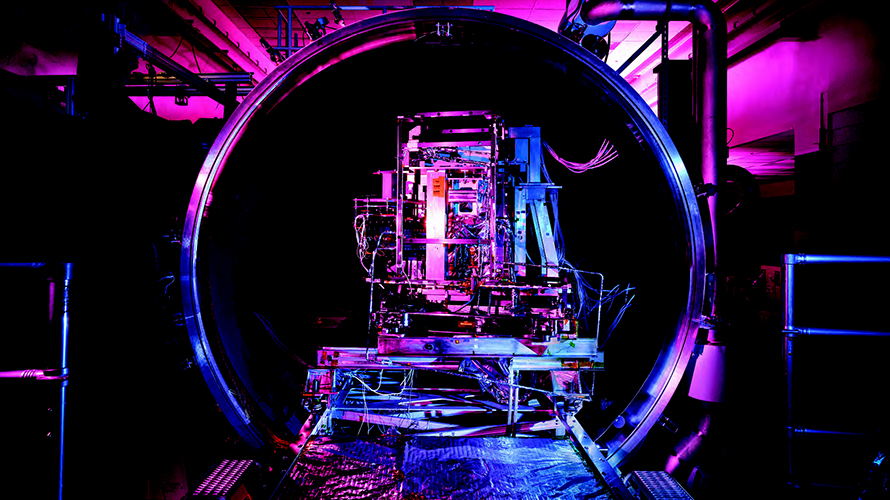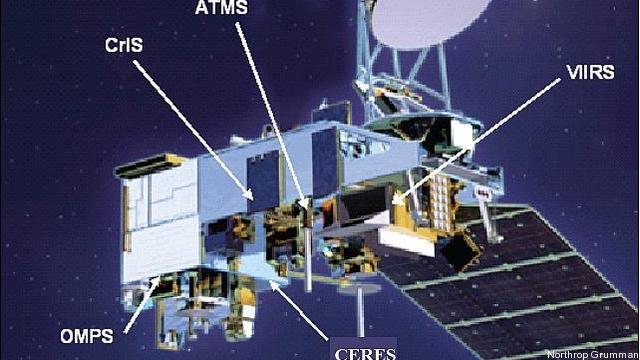Eye On AF Weather Sat Decisions, Raytheon Offers VIIRS [Sponsored]
Posted on

Raytheon’s Visible Infrared Imaging Radiometer Suite sensor
As the Air Force tries to decide — after more than a decade of false starts — just what weather satellites and sensors it needs to build, a Raytheon executive says his company is conducting an internal assessment of how it could meet any emerging needs.
“The Air Force now is going through a process, as the agency that provides defense weather capability, of determining what their capability needs are to meet the future specific needs of Department of Defense weather,” Wallis Laughrey, Raytheon Vice President for Space Systems. said. “They are going through a series of trades on whether to start their own new development program, and what other options are out there.”
For example, the service recently started two new programs, Operationally Responsive Space Number 8, “to meet the urgent needs for weather,” and the Weather System Follow-on — Microwave (WSF-M).
In response, Raytheon is “doing an assessment of how we meet the government’s capabilities requirements. And we’re certainly ready to respond, to support whatever the warfighters’ needs are. And what’s also more important in the current [budget] environment, the most affordable solution, that is cost- and schedule-assured,” he said.
Raytheon feels confident it could quickly meet any future Air Force weather technology requirements because, “we are currently providing that capability today, through what we build with VIIRS and what we fly right now working with our NASA, NOAA counterparts,” Laughrey said, referring to Raytheon’s Visible Infrared Imaging Radiometer Suite (VIIRS).

The cancelled NPOESS weather satellite
The current situation with space-based weather assets stems from a costly program failure of what was meant to be a common satellite system serving the military, NASA and NOAA, called the National Polar-orbiting Operational Environmental Satellite System (NPOESS).
NPOESS fell victim in 2010 to an array of problems, including political interference, bad requirements, cultural differences and the systems engineering challenges of tying to meet the different needs of defense, science and commerce. NASA and NOAA then joined in a program initially called NPOESS Preparatory Project (NPP), now called the Joint Polar Satellite System (JPSS). The Air Force fell back on its existing Defense Meteorological Satellite Program.
The NPP Suomi satellite was launched in October 2010, carrying a number of sensors including VIIRS, “which is the culmination of four legacy sensors into one,” Laughery said.
The most important capability was the electro-optical, infrared sensors which meet the government’s weather needs “across a whole range of different spectral bands,” he explained. “It’s the detection needs for the Navy, the Air Force, the other services and the Department of Defense, NOAA for all its forecasting needs, and NASA for the science community. They put all those capabilities into one sensor called VIIRS.”
VIIRS also was the primary sensor in the first JPSS, launched Nov. 18 last year.
Raytheon also produces the critical ground control systems that process the data from the NOAA/NASA weather satellites. Raytheon received a contract for three VIIRS sensor packages for the NPP/JPSS program. Two are in orbit and the third was delivered at the end of March.
“What’s important is, the nation, primarily through the civil side of the government, has invested in this architecture that flies these sensors in Low Earth Orbit (LEO) and it satisfies today the government’s needs for weather for what was originally intended to be NPOESS,” Laughrey said.
Laughrey stressed the importance of accurate weather for the military, calling it “almost the hidden equalizer.”
Certainly throughout history, unexpected bad weather has stymied the best military commanders. Consider the violent storm that shattered the Spanish Armada in 1588 and saved England from invasion, or the dense cloud coverage that repeatedly forced mass formations of 8th Air Force bombers to abort their missions over Germany in World War II.
Accurate weather information from space “is used for so many different things,” including flight planning for all the services and by the Navy for sea surface temperature readings that affect a range of conditions facing the surface fleets, Laughrey said.
A critical factor for weather data, particularly for flight planning, is the timeliness, how quickly can the warfighters get the weather data they need, he added.
Flight planners like to have “systems that fly in what is called the AM orbit, the early morning orbit,” because it gives them more timely data than from the PM orbit, which is where the science community flies its current weather constellation, he explained.
Another favorable attribute of the VIIRS sensor, Laughrey said, “it was built with the ability to fly in that early morning orbit, which is also challenging for a whole range of space weather aspects.”
Laughrey noted that one of the chronic problems with space programs has been the extensive time and cost required to design and develop a new system, which usually means a lot on non-recurring engineering before getting into production.
An advantage for Raytheon as the Air Force considers its future needs, he said, is that “we actually have a production line on a sensor that is satisfying all of our defense weather needs today, with a ground system that is satisfying all our needs today.”
That provides the opportunity to avoid the costly and time-consuming non-recurring engineering and to gain “the cost and schedule assurance to meet the warfighters needs today.”
One of the factors the Air Force may be considering in its current review is “whether or not they have enough sensors in orbit,” Laughrey suggested. That decision could be whether to “build more of what is meeting my needs today, or do I try to add something new. I think that is the trade that the government is going through now.”
“We’re really working hard to be positioned to go in either direction the government chooses to go in.”
Our request to Air Force Space Command for information on the scope and time-line of the weather satellite review was not yet answered when this was published.
Subscribe to our newsletter
Promotions, new products and sales. Directly to your inbox.
